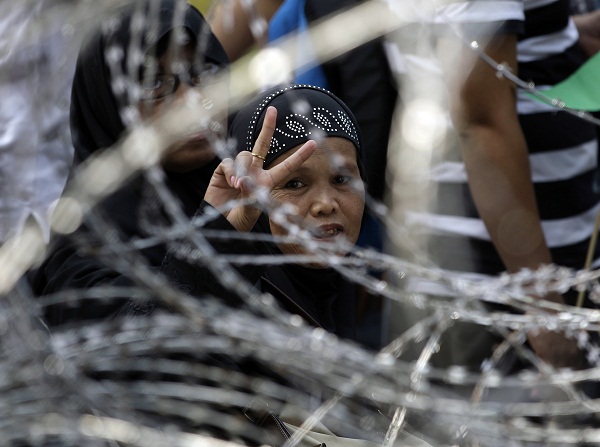
A Filipino Muslim woman flashes the peace sign behind a barb wired fence as they gather in support of a preliminary peace agreement between the government and the nation’s largest Muslim rebel group during a rally outside the gates of the Malacanang presidential palace in Manila, Philippines. AP FILE PHOTO
MANILA, Philippines — Fewer Filipinos remain hopeful a “just peace agreement” could be reached between the government and the Moro Islamic Liberation Front (MILF), according to a recent survey by Social Weather Stations (SWS).
The Second Quarter 2013 Social Weather Report, conducted in June, found that seven in every 10 Filipinos were hopeful about a peace agreement, lower than eight or 79 percent posted in March when the SWS conducted its first quarter 2013 survey.
The June survey found that 28 percent of respondents remained “very hopeful” about a peace deal, lower than the 41 percent “very hopeful” respondents in March.
The June survey found that across areas, Mindanao was the most hopeful about a peace agreement, with 34 percent saying they were “very hopeful” about it.
Around a third of the respondents ( 34 percent) said they did not expect a peace deal to be concluded ever, with only one in every four (25 percent) saying that they expected a peace agreement between the government and the MILF before the end of President Aquino’s term in 2016.
In terms of religion, 59 percent of Muslim survey respondents said they were “very hopeful” about a peace deal. Among Catholic respondents, the figure was 27 percent, while among other Christians surveyed, it was 29 percent.
The SWS survey was conducted from June 28 to 30 and used face-to-face interviews with 1,200 adults. It had a margin of error of plus-or-minus 3 percentage points.
Respondents were asked: “Are you very hopeful, somewhat hopeful, somewhat not hopeful, or not hopeful at all that there will be a just peace agreement between the government and the Moro Islamic Liberation Front (MILF)?”
The survey also asked respondents: “In your opinion, when will there be a peace agreement between the Moro Islamic Liberation Front or MILF and the government: 2013; 2014-2016, within the presidency of President Aquino; 2016-2022, in the next administration, or “not ever”?
The June survey showed that seven in every 10 Filipinos were “hopeful” about the peace deal, 28 percent were “very hopeful,” and 42 percent “somewhat hopeful.” Fourteen percent said they were “somewhat not hopeful” and 16 percent said they were “not hopeful at all.”
In its March survey, the SWS found that 79 percent of respondents were “hopeful” about the agreement, 41 percent were “very hopeful,” and 38 percent “somewhat hopeful.”
In Mindanao, 34 percent were “very hopeful” about the peace agreeement, while 37 percent were “somewhat hopeful,” 15 percent were “somewhat not hopeful” and 13 percent said they were “not hopeful at all.”
In Luzon outside Metro Manila, 71 percent said they were hopeful about the peace agreement, 24 percent said they were “very hopeful,” while 47 percent remained “somewhat hopeful.” They were “somewhat not hopeful,” according to 15 percent of the Luzon respondents, while 14 percent said they were “not hopeful at all.”
In Metro Manila, 67 percent were hopeful, 27 percent were “very hopeful,” and 40 percent were “somewhat hopeful.” Fifteen percent of the respondents said they were “somewhat not hopeful,” while 18 percent said they were “not hopeful at all.”
In the Visayas, 30 percent said they were “very hopeful,” while 36 percent said they were “somewhat hopeful” about the peace agreement. Twelve percent said they were “somewhat not hopeful,” and 22 percent said they were “not hopeful at all.”
Among Muslim respondents, 59 percent said they were “very hopeful,” 26 percent said they were “somewhat hopeful” about the peace agreement, while 15 percent said they were “somewhat not hopeful.”
Twenty-seven percent of the Catholic respondents said they were “very hopeful,” 43 percent said they were “somewhat hopeful,” 15 percent said they were “somewhat not hopeful” and another 15 percent said they were “not hopeful at all.”
Among the other Christians surveyed, 29 percent said they were “very hopeful,” 36 percent said they were “somewhat hopeful,” 12 percent said they were “somewhat not hopeful” and 23 percent said they were “not hopeful at all” about the peace agreement.
To the question on when respondents expected the peace agreement to be reached, 34 percent said “not ever,” while 28 percent said they expected a peace agreement in the next administration. About one in four (25 percent) said they expected a peace deal within the current administration, while 10 percent expected the peace agreement to be reached by the end of the year.
In Mindanao, 23 percent said they expected the peace agreement to be reached by 2013, while 27 percent said they expected it within the current administration. About a fourth (24 percent) said they expected the peace agreement to be reached during the next administration, while another 24 percent said “not ever.”
Respondents who also gave an emphatic “not ever” answer came from the Visayas (43 percent), Balance Luzon (35 percent), and Metro Manila (34 percent).
In areas outside Mindanao, less than one in every ten expects the deal to be reached by the end of the year (9 percent in Balance Luzon, 4 percent in Metro Manila and 3 percent in the Visayas), while about a fourth expect the deal to be reached by the end of President Aquino’s term (28 percent in the Visayas, 25 percent in Metro Manila and 22 percent in Balance Luzon).
Meanwhile, 34 percent in Metro Manila, 29 percent in Luzon outside Metro Manila and 24 percent in the Visayas said they expected the peace deal to be reached in the next administration. Inquirer Research